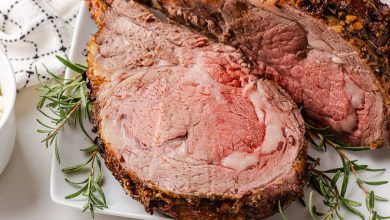Fresh Pork Leg (Ham) Rump Half – Raw
The fresh pork leg, also known as the ham rump half, is a tender and flavorful cut of meat, widely enjoyed for its versatility in various recipes. When prepared properly, it provides a rich, savory experience, ideal for roasting, grilling, or slow cooking. This cut is prized not only for its taste but also for its nutritional benefits. Below, we break down the key nutritional values and other essential information you should know about this cut of pork.
Nutritional Information (per 100g)
| Nutrient | Amount |
|---|---|
| Energy | 120 kcal |
| Protein | 21.81 g |
| Fat | 2.93 g |
| Saturated Fat | 0.947 g |
| Carbohydrates | 0.0 g |
| Fiber | 0.0 g |
| Sugar | 0.0 g |
| Calcium | 12 mg |
| Iron | 0.67 mg |
| Magnesium | 22 mg |
| Phosphorus | 235 mg |
| Potassium | 359 mg |
| Sodium | 76 mg |
| Zinc | 1.85 mg |
| Copper | 0.08 mcg |
| Manganese | 0.01 mg |
| Selenium | 21.2 mcg |
| Vitamin C | 0.0 mg |
| Thiamine (B1) | 0.545 mg |
| Riboflavin (B2) | 0.34 mg |
| Niacin (B3) | 6.042 mg |
| Vitamin B6 | 0.557 mg |
| Folate (B9) | 0.0 mcg |
| Vitamin B12 | 0.36 mcg |
| Vitamin A | 2.0 mcg |
| Vitamin E | 0.16 mg |
| Vitamin D2 | 0.3 mcg |
Allergen Information
Fresh pork leg (ham) is a meat product, and as such, does not contain common allergens such as dairy, gluten, or nuts. However, it’s important to note that any seasoning or marinades used in preparation could contain allergens, so it’s always advisable to check the ingredients of any added products for potential allergens.
Dietary Preferences
This fresh pork leg is naturally free from gluten, dairy, and sugars, making it suitable for a variety of dietary needs, including:
- Low Carb: Perfect for those following a low-carb or keto diet.
- Paleo: As a whole food, it aligns well with the paleo diet, provided no non-paleo ingredients are added during preparation.
- High Protein: With over 21 grams of protein per 100g, it’s an excellent option for those seeking to increase their protein intake.
Cooking Advice
The fresh pork leg is incredibly versatile and can be cooked in a variety of ways depending on your preferences. It can be roasted to perfection, grilled for a charred finish, or slow-cooked for tenderness. Here are some tips to get the most out of this cut:
-
Roasting: Season the pork leg with your favorite herbs and spices, such as garlic, rosemary, and thyme, for a classic flavor profile. Roast at a high temperature initially to form a crispy outer layer, then reduce the heat to ensure it cooks evenly and remains juicy.
-
Slow Cooking: The fresh pork leg can also be slow-cooked in a crockpot or Dutch oven for several hours. This method breaks down the connective tissues, making it fork-tender and ideal for pulled pork dishes.
-
Grilling: For a deliciously smoky flavor, you can grill the pork leg, basting with your favorite marinade to enhance its natural flavors.
-
Slicing and Serving: Once cooked, slice the pork leg thinly against the grain to ensure maximum tenderness. It can be served with sides like mashed potatoes, roasted vegetables, or a light salad.
Conclusion
The fresh pork leg (ham) rump half is not only a flavorful and versatile cut of meat but also provides an excellent source of protein and essential nutrients like phosphorus, potassium, and B vitamins. Whether you’re grilling, roasting, or slow-cooking, this cut offers both delicious flavor and a host of nutritional benefits, making it a great addition to your meal planning. Always remember to tailor your preparation to suit your dietary preferences and cooking style, and enjoy the rich taste of this beloved cut of pork!










